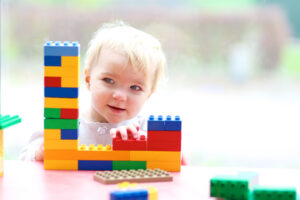Parenthood lies deep within us. We are wired to help our little ones survive and prosper.
Modern life, however, has removed us from our natural environment. It can be hard to raise a child in world of fear and distractions. Science and psychology bring back a big dose of reality and give practical tips for how you can help your kids turn into amazing human beings.
Rogers’ Secret for Personal Growth

Carl Rogers, a famous psychologist, believed that all humans have a built-in need for personal growth and self-actualization. To unleash this great power within us, we have to remove our internal blocks [1].
An important part of his theory was our strong need for positive regard. We need others to regard us in a positive light – we need sympathy, love and acceptance.
Positive regard comes in two different packages – unconditional or conditional.
Related reading: How to Grow Through Blockages and Find Your True Self
Perform and then You’ll Have My Love
Conditional positive regard is when parents only show affection when children behave in a way that pleases them. Research shows that conditional positive regard can have long-term consequences.
“The last year of high school is over and Sarah is coming home with her final grades. She’s gotten all A’s with one exception – a C in math. She proudly hands it over to her father who says, ‘Why did you get a C in math? You could do better than this’, then his gaze returns to the TV. Sarah goes up to her room disappointed in herself and frustrated with her father.”
College students who reported that parents used conditional positive regard for emotional control, prosocial behavior, academics and sports performance experienced large fluctuations in self-esteem and how they thought their parents perceived them. They tended to resent their parents [2].
When you’re under the curse of conditional love, you’re never enough. You always have to do better, get better and earn more before you can start loving yourself.
No Matter the Grade, My Love Will Never Fade
“Unconditional positive regard communicates that the person is inherently worthy of love, regardless of accomplishments or behavior.” – Carl Rogers
Children need unconditional love. They need to feel safe. When they feel safe, they go out into the world and explore. They are unafraid to take chances and mess up a few times, because they know that love will not be taken away.
We also have a need for positive self-regard – to view ourselves in a positive way. When we only receive conditional love as children, we learn that we are only worthy of love when we behave in a certain way. We start putting up conditions for when we can feel good about ourselves. A conflict arises between our self-concept and our experience of the world. We start suppressing and denying those parts of ourselves that our parents disapproved of.
The simple remedy is: Love your children fiercely, and love them unconditionally.
When we receive unconditional love from our parents, we are more likely to love ourselves unconditionally. When we love ourselves unconditionally, we are not afraid to be ourselves because love is always there.
If you know that you are putting up conditions for what you need to do or accomplish before you are allowed to love yourself; let go, right now. Forgive your parents. Forgive yourself. The moment to decide is always right now, in this present moment. Decide now that you will love yourself unconditionally. The decision is the first step. Give the same gift to your children.
How to Raise Smart Kids
 Carol Dweck is a professor of psychology at Stanford University. In her mind-blowing book, “Mindset: The New Psychology of Success”, she shines the light on how our mindsets affect our performance. Her focus is on the difference between having a fixed mindset and a growth mindset.
Carol Dweck is a professor of psychology at Stanford University. In her mind-blowing book, “Mindset: The New Psychology of Success”, she shines the light on how our mindsets affect our performance. Her focus is on the difference between having a fixed mindset and a growth mindset.
People with a fixed mindset believe that intelligence and ability is fixed by our genes and that these inborn abilities determine our level of success. Those that have a growth mindset believe that they can learn and achieve anything if they put in the effort.
The Depressing Fate of “Intelligent” Kids
Our society is fixated on talent and natural inborn ability in high-level performance. But this view of performance doesn’t hold up to scrutiny. Research shows us, again and again, that hard work and effort is the secret sauce behind mastery. One longitudinal study showed that self-discipline outdoes IQ in predicting academic performance of adolescents [3].
Another study showed how praise for children’s intelligence undermined both their motivation and performance [4]. The “smart and intelligent” kids tend to fall by the wayside as soon as they hit difficulties. Children given praise for their ability give up faster than children given praise for their effort [5].
Do You Ignore the Effort Behind?
The problem with amazing performance is that it is difficult to understand. Usually, we do not see all the work behind it – we only see the performances. Cognitive neuroscience has shown us that we humans take many shortcuts in our thinking. One of these shortcuts is WYSIATI – “what you see is all there is” [6]. We make decisions based only on what we see – “Known Knowns”. And we tend to ignore what we don’t have information about, but know to be relevant – “Known Unknowns”. We completely ignore “Unknown Unknowns”.
Talent becomes an excuse for why we are not great ourselves. It is easier to attribute other’s success to their inborn talent, because then we do not have to look at ourselves. But what we believe to be talent is always the result of thousands of hours of hard work and effort. This is the message children need to hear – you can do anything if you put in the effort required.
How to Give Your Kids a Mindset for Growth
When you give your kids praise, focus on their effort. This primes their minds for more effort. Always focus on the process and not on results. The process is always within their control. They decide how much effort to put into it. Results, on the other hand, are to a large degree outside of their control. Focusing on the process also teaches them to be more present to what is happening. Teach them that the brain is a learning machine that they can constantly upgrade. Over time they will develop the belief that they can do anything.
This is related to the concept of unconditional positive regard. Praise for results can easily be mistaken as conditional love.
The Save When You Forget Yourself
I am often guilty of giving praise to children for results, but I have taught myself some saves. Here are some examples:
|
Praise for results |
The save |
|
“You are so skilled!” |
“… at making a great effort and not giving up.” |
|
“What a great goal you scored!” |
“… your time spent practicing is paying off.” |
|
You got an A! That’s great!” |
“… I am so proud that you spent all those hours studying and upgrading your brain.” |
Vygotsky’s Secrets of Cognitive Development
Lev Vygotsky, a famous russian psychologist, viewed children as busy explorers, thirsty for knowledge. He emphasized how cultural and social factors influence how children develop [7]. Three of the central ideas in his theory were private speech, the zone of proximal development, and make-believe play – parents have a vital role in all.
Private Speech
 An important part of children’s development is private speech. Children talk to themselves to help their thinking and solve tasks.
An important part of children’s development is private speech. Children talk to themselves to help their thinking and solve tasks.
As they get better at cognitive tasks, the speech slowly turns internal. Research the last three decades supports Vygotsky’s view [8].
Children who use private speech to help them in challenging tasks are more focused and better at solving problems than children who are silent.
Children learn private speech from grown-ups who have mastered the learning zone.
Master the Learning Zone
Vygotsky believed that children learn the fastest in their “zone of proximal development”. The zone is a range of tasks too difficult to figure out for the child without aid from adults or more skilled peers. There are two important features of social interaction between parent and child that promotes cognitive development in the “zone”:
Drawing the Child in with Intersubjectivity
Intersubjectivity is when the parent and child start with different understandings, but arrives at a mutual understanding of the task [9]. Parents promote intersubjectivity when they take their more advanced insights and boil it down to something the child can understand. The child has to stretch his or her mind to understand the parent, and is drawn into the more mature way of thinking.
Research shows that when parents use intersubjectivity in a good way, children develop faster in competencies such as attention, language, complex play and understanding other’s perspectives [10,11]. Parents do this by being supportive, stimulating and responsive.
Pulling the Child up with Scaffolding
Scaffolding is adjusting the support or guidance to fit the child’s level of performance. This can be done with direct instruction, breaking the task into smaller more manageable units, suggesting tactics or strategies or by explaining how things can be done.
When the child becomes more skilled the wise parent gradually withdraws support until the child is independently solving the task. Children often start using the language of these discussions for their private speech. This helps them organize their thoughts.
“Ken, the 16 month old, is trying to put different shapes into a box. He has to put them through the correct holes to get them in. He picks up the square peg and tries to fit it into the round hole, but it won’t go in. He tries several times before he looks at his mom, slight irritation showing on his face. The first thing he sees is a patient, smiling face.
Gently, she offers her advice: ‘You can try another piece, when something doesn’t fit after you try it 3 times.’ Then she points at the square hole and says, ‘A square hole. Hmmm, I wonder if this peg with a square end might fit’, before she demonstrates how to put it in.”
Research shows that when parents use scaffolding in a good way, children develop faster in attempting to solve difficult tasks, cognitive development, mature thinking and academic competence [12]. Parents’ encouragement and emotional support, and their gradual responsibility transfer to the child, predicts how much effort children put into tasks [13].
The Cognitive Magic of Make-Believe
According to Vygotsky’s theory, make-believe play is an important part of how children develop their cognitive abilities. It is a great platform for children to try out a wide range of skills and might be the most important source of development before they start school.
When they engage in make-believe play they learn how to act from internal ideas instead of just reacting to the environment. And, since make-believe is rule-based, they learn to think before they act and to control their impulses. It is also a great way for them to learn social norms and expectations. Research also shows that when children act out dramatic plays, they tend to become better at regulating their emotions and behavior [14,15].
“4 year old Katie is playing that she is the parent of her doll. She feeds her baby at regular intervals; she tries to use proper “parent language” and she puts her baby to bed when it’s late.”
The Special Role of Mothers
 Research indicates that make-believe play does not spontaneously arise in children. Rather, they are slowly taught under guidance. Mother’s typically have an especially important role here. Research shows that 75-80% of make-believe play was between mother and child [16].
Research indicates that make-believe play does not spontaneously arise in children. Rather, they are slowly taught under guidance. Mother’s typically have an especially important role here. Research shows that 75-80% of make-believe play was between mother and child [16].
When children are 12 months old mothers initiate almost all make-believe play, but by the second year the ratio of initiation is close to 50-50. An important finding is that the more parents pretend with their children, the more time the children spend on make-believe.
“2 year old Peter wants to join his mother in preparing the stew they have for dinner. His mother finds him a small pot and pretends to put in onions and carrots, all the while looking at Peter and smiling. She asks Peter, ‘What else should we put in our stew?” and pretends to stir the stew with a wooden spoon, before she hands it over to Peter.”
Typical cues that mothers use to signal that they are pretending are [17]:
– Looking at their child and smiling more
– Exaggerated movements
– Use more “we” talk, than during “real” events
These cues make it easier for the child to understand that it is not real and that he or she can join in.
The short story is that your child benefits from playing make-believe together with you. If you regard make-believe as something fun and exciting you do together with your child, you’re doing good.
Temperament and Shyness
Temperament is viewed as stable individual differences in reactivity and self-regulation [7]. Reactivity is how quickly and intensely we get emotionally aroused, shift our attention and spring into action. Self-regulation is how effectively we modify our own reactivity [18]. Individual differences in reactivity and self-regulation tend to appear early.
How children score on these two dimensions predicts how well they will be protected from psychological problems due to an early stressful life.
Neurobiological Differences between Sociable and Shy Children
New experiences and stimuli tend to excite the amygdala to a higher degree in shy children than in sociable children. The amygdala is the main brain structure behind avoidance behavior. It activates the sympathetic nervous system and prepares the body to react to dangers. The same experiences in sociable children leads to a very small reaction in the amygdala [19].
The heart rates of inhibited children are consistently higher [20]. It also speeds up even more in response to unfamiliar events. They have higher levels of the stress hormone cortisol [21,22]. And when they’re faced with new experiences they also tend to have more dilated pupils, higher blood pressure and colder fingertips [23,24].These responses are controlled to a large degree by the amygdala.
Potential Problems with Shyness
When children do not overcome their shyness it increases the probability of developing problems with excessive cautiousness, low self-esteem and loneliness [25]. It also increases the chances of developing severe anxiety and social phobia – an intense fear of being humiliated in social settings [19].
How to Help Your Children Overcome Shyness
Research indicates that genes only moderately contribute to shyness and sociability [13]. Experience has been shown to have a powerful impact. Warm and supportive parenting reduces shy infants’ physical reaction to new experiences. When parents are cold and intrusive, on the other hand, it tends to increase anxiety [26, 27].
Overprotection makes it harder for shy children to develop the courage to face new experiences. It is better to make loving and caring demands for them to face new experiences. This helps them develop strategies for regulating fear [28].
The Antidote for Fear
 There is a proven way to calm down. After less than 8 weeks of meditation, scientists notice significant changes in the size of several brain regions on MRI scans [29, 30]. The fear center of the brain, the amygdala, has been found to shrink in size in response to meditation. Even as little as three days of meditation has been shown to reduce the activity of the fear center [31].
There is a proven way to calm down. After less than 8 weeks of meditation, scientists notice significant changes in the size of several brain regions on MRI scans [29, 30]. The fear center of the brain, the amygdala, has been found to shrink in size in response to meditation. Even as little as three days of meditation has been shown to reduce the activity of the fear center [31].
Other brain areas increase in size – especially brain areas associated with attention, emotional regulation, mental flexibility and memory.
Read more about how meditation restructures your brain: Overthinking too Much? Science Confirms: Meditation Is the Solution
Parents can start early giving their children strategies to let go of thoughts that are causing them trouble. As we have seen in this article, it is important that parents do this from a place of unconditional love. Put special emphasis on growth and effort, and use intersubjectivity and scaffolding to teach them within their zone of proximal development. Throw in some make-believe play about being buddhist monks and you’ll have a calm child in no time.
Don’t Be Hard on Yourself
There is of course an interaction between genes and environment in the development of children. You as a parent are only one part of the whole environment in which children grow up. Good parenting can only minimize the probability of difficulties. Do your best and let chance handle the rest.
Summary – 7 Things to Do as a Parent
This whole article can be summarized with 7 items:
-
Love unconditionally
-
Praise for effort, not achievements
-
Stimulate and respond
-
Gradually leave responsibility over to the child
-
Play make-believe
-
Be warm and supportive
-
Make loving, caring demands to face new experiences
But the greatest of these is unconditional love.
Author bio:
Vegard Gjerde is one of the two founders of Global Harmony Crew.
Global Harmony Crew guides people towards deep self-realisation and powerful self-actualisation. Join the crew by subscribing and you will learn about everything from the deep metaphysical questions, to basic steps you can take in your day-to-day life to manifest happiness and fulfilment. Follow Global Harmony Crew on Facebook.
References:
[1] Passer, M. et. al. ”Psychology – The Science of Mind and Behavior” 4th ed. McGraw-Hill, 2008.
[2] Assor, A., et al. “The emotional costs of parents’ conditional regard: A self-determination theory analysis”. Journal of Personality, 2004.
[3]Duckworth, A., Seligman, M. “Self-Discipline Outdoes IQ in Predicting Academic Performance of Adolescents”. Psychological Science, 2005.
[4] Mueller, C. M., Dweck, C. S. “Praise for Intelligence Can Undermine Children’s Motivation and Performance”. Journal of Personality and Social Psychology, 1998.
[5] Cimpian, A. et al. “Subtle Linguistic Cues Affect Children’s Motivation”. Psychological Science, 2007.
[6] Kahneman, Daniel. “Thinking, Fast and Slow”. MacMillian, 2001.
[7] Berk, L. E. Child Development. Pearson, 2013.
[8] Berk, L. E. Harris, S. Vygotsky, Lev. In L. Nade. Encyclopedia of Cognitive Science, 2003.
[9] Newson, J, Newson, E. “Intersubjectivity and the transmission of culture: on the social origins of symbolic functioning”. Bulletin of the British Psychological Society, 28, 437-446, 1975.
[10] Bornstein, M. et al. “Toddler language and play in the second year: Stability, covariation, and influences of parenting”. First Language, 1992.
[11] Charman, T. et al. “Testing joint attention, imitation and play as infancy precursors to language and theory of mind.” Cognitive Development, 2001
[12] Berk, L. E., Spuhl, S. T. “Maternal interaction, private speech, and task performance in preschool children”. Early Childhood Research Quarterly, 1995 .
[13] Neitzel, C. Stright, A. D. “Mothers’ scaffolding of children’s problem solving: Establishing a foundation of academic self-regulatory competence”. Journal of Family Psychology, 2003.
[14] Berk, L. E. et al. “Make-believe play: Wellspring for development of self-regulation”. Play = Learning, New York, Oxford University Press, 2006.
[15] Lemche, E. et al. “Emotion-regulatory process in evoked play-narratives: Their relation with mental represenations and family interactions”. Praxis der Kinderpsychologie und Kinderpsychiatrie, 2003.
[16] Haight, W. L., Miller, P. J. “Pretending at home: Early development in a sociocultural context”. Albany, NY: SUNY Press, 1993.
[17] Lillard, A. “The science behind the genius”. New York, Oxford University Press, 2007.
[18] Rothbart, M. K., Bates J. E. “Temperament”. Social, emotional and personality development. Hoboken, NJ: Wiley, 2006.
[19] Kagan, J., Fox, N. A. “Biology, culture and temperamental biases”. In handbook of child psychology, Hoboken, NJ: Wiley, 2006.
[20] Schmidt, L. A. et al. “Shyness is a necessary but not sufficient condition for high salivary cortisol in typically developing 10-year old children”. Personality and Individual Differences, 2007.
[21] Schmidt, L. A. et al. “Behavioural and neuroendocrine responses in shy children”. Developmental Psychobiology, 1997.
[22] Schmidt, L. A. et al. “Behavioural and psychophysiological correlates of self-presentation in temperamentally shy children”. Developmental Psychobiology, 1999.
[23] Kagan, J., et al. “Infant temperament and anxious symptoms in school-age children.” Development and Psychopathology, 1999.
[24] Kagan, J., et al. “The preservation of two infant temperaments into adolescence”. Monographs of the society for Research in Child Development, 2007.
[25] Fordham, K., Stevenson-Hinde, J. “Shyness, friendship quality, and adjustment during middle childhood.” Journal of Chiuld Psychology and Psychiatry, 1999.
[26] Coplan, R. J. et al. “Don’t fret, be supportive! Maternal characteristics linking child shyness to psychosocial and school adjustment in kindergarten.” Journal of Abnormal Child Psychology, 2008.
[27] Hane, A. A. et al. “The role of maternal behavior in the relation between shyness and social reticence in early childhood and social withdrawal in middle childhood”. Social Development, 2008.
[28] Rubin, K., Burgess, K. B. “Parents of aggressive and withdrawn children”. Handbook of Parenting, Hillsdale, NJ: Erlbaum, 2002.
[29] Luders, E. et al. “The underlying anatomical correlates of long-term meditation: Larger hippocampal and frontal volumes of gray matter”. Elsevier, 2009.
[30] Hölzel, B. K. et al. “Stress reduction correlates with structural changes in the amygdala”. Social Cognitive and Affective Neuroscience, 2010.
[31] Taren, A. A. et al.” Mindfulness meditation training alters stress-related amygdala resting state functional connectivity: a randomized controlled trial”. Social Cognitive and Affective Neuroscience, 2015.

